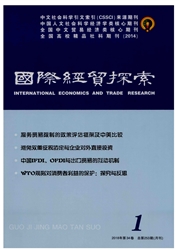

 中文摘要:
中文摘要:
文章构建了一种要素、二个部门、三个地区的空间贸易模型,以考察中国出口贸易的动态区域分布。研究表明:在空间巴拉萨—萨缪尔森效应下,沿海地区的工资租金比下降,催生劳动力向沿海聚集,强化了其地理比较优势;沿海地区以港口为节点的多式联运系统显著降低了国际货运成本,提高了其出口份额;地方保护主义抬高了境内运输成本,梗阻了内地与沿海港口的对接,割裂了东西部地区之间的产业循环,不利于中西部地区融入全球价值链;刘易斯拐点的逼近抬高了沿海地区的劳动力成本,但没有突破产业集聚的支撑点,短期内沿海地区的“出口奇迹”仍将延续。因此,我们要继续发挥东部地缘优势,发展内河运输和铁路运输,降低境内运输成本;加强中西部地区基础设施建设,强化公共服务支撑,提高承接产业转移的能力。
 英文摘要:
英文摘要:
This paper constructs a spatial trading model including one factor, two departments and three regions, to study the regional distribution of China's export trade. The research result shows that: the spatial Balassa-Samuelson effect makes the wage rent ratio decrease in the coastal areas, and strengthens the geographical comparative advantage and the export competitiveness of these areas. The multimodal transport system in the coastal areas significantly reduces international transportation costs, and improves export proportion, however, the export trade of the border areas is limited by the stage and scale of economic development. Local protectionism raises the domestic transportation cost, impedes the link between inland and coastal regions, and is not conducive to the central and western regions into the global value chain. The approximation to Lewis turning point elevates labor costs of the coastal areas, but don't waver their comprehensive operating cost advantages, so the coastal areas will continue prolonging their export miracle in the short run. Therefore, we should continue to play geographical advantages of the eastern region, develop the inland waterway transport, strengthen the construction of infrastructure in the central and western regions, develop export-oriented facilities, and improve the ability of undertaking industries.
 同期刊论文项目
同期刊论文项目
 同项目期刊论文
同项目期刊论文
 期刊信息
期刊信息
